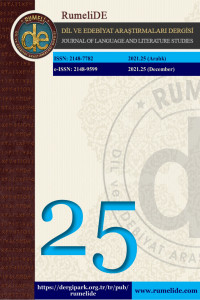Öz
Türk dilinde benzetme denildiğinde akla ilk olarak gibi edatının ve bu edatla kurulan benzetmeli yapıların geldiği söylenebilir. Gibi edatıyla kurulan kelime gruplarının deyim mi yoksa kalıp söz mü olduğu tartışılagelmektedir. Deyim ve kalıp söz kavramlarına ilişkin kapsamlı araştırmalar ve tartışmalar içeren çalışmalar ortaya konulmasına rağmen bu yapıların benzerlik ilgisi kuran gibi edatı ve ol- fiiliyle birlikte kullanılan olduğu gibi yapısıyla ilişkisine değinilmemiştir. Gibi edatı ve bu edatın oluşturduğu edat gruplarına ilişkin anlamsal farklılıkların ortaya konulduğu çalışmalar yapılsa da olduğu gibi yapısı ve bu yapının çok anlamlılık özelliği barındırdığı göz ardı edilmiştir. Bu çalışmayla, Türk Dil Kurumu Türkçe Sözlük’te madde içi olarak yer verilmemiş olan olduğu gibi yapısına dikkat çekmek, yapının çok anlamlılık özelliğini vurgulamak, dolayısıyla Türkçenin söz varlığına da katkıda bulunmak amaçlanmıştır. Çalışmaya konu olacak örnek cümlelerin tespiti için telif hakları konusunda titiz davranılarak ve hiçbir ayrım gözetmeksizin seçilen 28 farklı yazardan 50 farklı roman taranmıştır. Tarama neticesinde tespit edilen olduğu gibi yapısının tanıkladığı cümleler, anlamsal farklılıklar gözetilerek tasniflenmiştir.
Anahtar Kelimeler
Kaynakça
- Aksoy, Ömer Asım (1988). Atasözleri ve Deyimler Sözlüğü 1 Atasözleri Sözlüğü. İstanbul: İnkılap.
- Altuntaş, Ali Fuat (2017). Türkiye Türkçesinde Gibi Edatıyla Kurulan Kalıp Sözler Deyimler. Bolu: Basılmamış Yüksek lisans tezi.
- Çotuksöken, Yusuf (1992). Deyimlerimiz. İstanbul: Özgül.
- Gökdayı, Hürriyet (2011). Türkçede Kalıp Sözler. İstanbul: Kriter.
- Hacıeminoğlu, Necmettin (1992). Türk Dilinde Edatlar. İstanbul: MEB.
- Karaağaç, Günay (2013). Anlam ( Anlam Bilimi ve İletişim ). İstanbul: Kesit.
- Karaağaç, Günay (2013). Dil Bilimi Terimleri Sözlüğü. Ankara: TDK.
- Korkmaz, Zeynep (2007). Gramer Terimleri Sözlüğü. Ankara: TDK.
- Merriam Webster’s Dictionary of Synonyms (1984). ABD.
- Sev, Gülsel (2007). Tarihi Türk Lehçelerinde Hâl Ekleri. Ankara: Akçağ.
- Sev, Gülsel (2012). “Türkiye Türkçesinde Gibi Edatıyla Kurulan Benzetmeli Anlatımlar.” Turkish Studies, Volume 7/4, 2012, s.499-512, Ankara.
- Türkçe Sözlük (2011). Ankara: TDK.................................
- Üstünova, Kerime (2010). Dilbilgisi Sorunları ‘-Ecekmiş Gibiyim’ Yapısının Düşündürdükleri. İstanbul: Kesit.
- Üstünova, Kerime (2008). Ad İşletimi. İstanbul: Kesit..............
- Vardar, Berke (2002). Açıklamalı Dilbilim Terimleri Sözlüğü. İstanbul: Multılıngual Yabancı Dil.
Öz
It can be said that the preposition gibi and the analogous structures formed with this preposition come to mind first when analogy is mentioned in the Turkish language. It has been discussed whether the word groups formed with the preposition gibi are idioms or formulaic expressions in Turkish language. Despite the extensive research and discussions regarding the idioms and formulaic expressions in Turkish language, the relation of these analogous structures to the structure olduğu gibi, which is formulated with the preposition gibi and the verb ol-, has not been mentioned. Although there are studies that reveal the semantic differences related to the preposition gibi and the preposition groups formed by this preposition, polysemous feature of this structure has been overlooked. This study aims to draw attention to the structure olduğu gibi, which is not included as an item in the Turkish Dictionary provided by Turkish Language Association and to emphasize the polysemous feature of the structure and thus to contribute to the vocabulary of the Turkish language. In order to determine the sample sentences to be analyzed in this study, 50 different novels from 28 different authors were scanned by paying due attention to the copyright arrangements and without showing any prejudices concerning the selection of the books. As a result of the scanning, the sentences including the structure olduğu gibi were classified considering the semantic differences.
Anahtar Kelimeler
Kaynakça
- Aksoy, Ömer Asım (1988). Atasözleri ve Deyimler Sözlüğü 1 Atasözleri Sözlüğü. İstanbul: İnkılap.
- Altuntaş, Ali Fuat (2017). Türkiye Türkçesinde Gibi Edatıyla Kurulan Kalıp Sözler Deyimler. Bolu: Basılmamış Yüksek lisans tezi.
- Çotuksöken, Yusuf (1992). Deyimlerimiz. İstanbul: Özgül.
- Gökdayı, Hürriyet (2011). Türkçede Kalıp Sözler. İstanbul: Kriter.
- Hacıeminoğlu, Necmettin (1992). Türk Dilinde Edatlar. İstanbul: MEB.
- Karaağaç, Günay (2013). Anlam ( Anlam Bilimi ve İletişim ). İstanbul: Kesit.
- Karaağaç, Günay (2013). Dil Bilimi Terimleri Sözlüğü. Ankara: TDK.
- Korkmaz, Zeynep (2007). Gramer Terimleri Sözlüğü. Ankara: TDK.
- Merriam Webster’s Dictionary of Synonyms (1984). ABD.
- Sev, Gülsel (2007). Tarihi Türk Lehçelerinde Hâl Ekleri. Ankara: Akçağ.
- Sev, Gülsel (2012). “Türkiye Türkçesinde Gibi Edatıyla Kurulan Benzetmeli Anlatımlar.” Turkish Studies, Volume 7/4, 2012, s.499-512, Ankara.
- Türkçe Sözlük (2011). Ankara: TDK.................................
- Üstünova, Kerime (2010). Dilbilgisi Sorunları ‘-Ecekmiş Gibiyim’ Yapısının Düşündürdükleri. İstanbul: Kesit.
- Üstünova, Kerime (2008). Ad İşletimi. İstanbul: Kesit..............
- Vardar, Berke (2002). Açıklamalı Dilbilim Terimleri Sözlüğü. İstanbul: Multılıngual Yabancı Dil.
Ayrıntılar
| Birincil Dil | Türkçe |
|---|---|
| Konular | Dilbilim |
| Bölüm | Türk dili, kültürü ve edebiyatı |
| Yazarlar | |
| Yayımlanma Tarihi | 21 Aralık 2021 |
| Yayımlandığı Sayı | Yıl 2021 Sayı: 25 |


